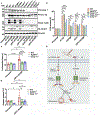Inflammasome activation and pyroptosis mediate coagulopathy and inflammation in Salmonella systemic infection
- PMID: 37467711
- PMCID: PMC10693354
- DOI: 10.1016/j.micres.2023.127460
Inflammasome activation and pyroptosis mediate coagulopathy and inflammation in Salmonella systemic infection
Abstract
Inflammasome activation is a critical defense mechanism against bacterial infection. Previous studies suggest that inflammasome activation protects against Salmonella oral infection. Here we find inflammasome activation plays a critical role in the pathogenesis of Salmonella systemic infection. We show that in a systemic infection model by i.p. injection of Salmonella, deficiency of caspase-1 or gasdermin-D prolonged survival time, reduced plasma concentrations of the proinflammatory cytokines IL-1β, IL-6 and TNFα. These deficiencies also protected against coagulopathy during Salmonella infection as evidenced by diminished prolongation of prothrombin time and increase in plasma thrombin-antithrombin complex concentrations in the caspase-1 or gasdermin-D deficient mice. Activation of the NAIP/NLRC4 inflammasome by flagellin and/or the components of the SPI1 type 3 secretion system played a critical role in Salmonella-induced coagulopathy. In the absence of flagellin and SPI1, the Salmonella mutant strain still triggered coagulopathy through the caspase-11/NLRP3 pathway. Our results reveal a previously undisclosed role of the inflammasomes and pyroptosis in the pathogenesis of Salmonella systemic infection.
Keywords: Coagulation; DIC; Inflammasome; Macrophage; Pyroptosis; Salmonella.
Copyright © 2023 Elsevier GmbH. All rights reserved.
Conflict of interest statement
Declaration of Competing Interest The authors declare that they have no known competing financial interests or personal relationships that could have appeared to influence the work reported in this paper.
Figures






Similar articles
-
Salmonella enterica Serovar Typhimurium Induces NAIP/NLRC4- and NLRP3/ASC-Independent, Caspase-4-Dependent Inflammasome Activation in Human Intestinal Epithelial Cells.Infect Immun. 2022 Jul 21;90(7):e0066321. doi: 10.1128/iai.00663-21. Epub 2022 Jun 9. Infect Immun. 2022. PMID: 35678562 Free PMC article.
-
Flagellin-induced NLRC4 phosphorylation primes the inflammasome for activation by NAIP5.Proc Natl Acad Sci U S A. 2015 Feb 3;112(5):1541-6. doi: 10.1073/pnas.1417945112. Epub 2015 Jan 20. Proc Natl Acad Sci U S A. 2015. PMID: 25605939 Free PMC article.
-
IRF8 Regulates Transcription of Naips for NLRC4 Inflammasome Activation.Cell. 2018 May 3;173(4):920-933.e13. doi: 10.1016/j.cell.2018.02.055. Epub 2018 Mar 22. Cell. 2018. PMID: 29576451 Free PMC article.
-
Advances in Understanding Activation and Function of the NLRC4 Inflammasome.Int J Mol Sci. 2021 Jan 21;22(3):1048. doi: 10.3390/ijms22031048. Int J Mol Sci. 2021. PMID: 33494299 Free PMC article. Review.
-
Molecular mechanisms activating the NAIP-NLRC4 inflammasome: Implications in infectious disease, autoinflammation, and cancer.Immunol Rev. 2020 Sep;297(1):67-82. doi: 10.1111/imr.12906. Epub 2020 Jul 29. Immunol Rev. 2020. PMID: 32729154 Review.
Cited by
-
Equal volume impregnation-air calcination synthesis of lithium-doped MgO nanoplates for enhanced antibacterial performance.RSC Adv. 2025 Feb 19;15(7):5639-5647. doi: 10.1039/d4ra07138g. eCollection 2025 Feb 13. RSC Adv. 2025. PMID: 39974314 Free PMC article.
-
Discrete and conserved inflammatory signatures drive thrombosis in different organs after Salmonella infection.Nat Commun. 2025 Mar 10;16(1):2356. doi: 10.1038/s41467-025-57466-6. Nat Commun. 2025. PMID: 40064845 Free PMC article.
-
NLRP3 Inflammasomes: Dual Function in Infectious Diseases.J Immunol. 2024 Aug 15;213(4):407-417. doi: 10.4049/jimmunol.2300745. J Immunol. 2024. PMID: 39102612 Free PMC article. Review.
-
Beyond Inflammation: Role of Pyroptosis Pathway Activation by Gram-Negative Bacteria and Their Outer Membrane Vesicles (OMVs) in the Interaction with the Host Cell.Cells. 2024 Oct 23;13(21):1758. doi: 10.3390/cells13211758. Cells. 2024. PMID: 39513865 Free PMC article. Review.
-
Salmonella exploits host- and bacterial-derived β-alanine for replication inside host macrophages.Elife. 2025 Jun 19;13:RP103714. doi: 10.7554/eLife.103714. Elife. 2025. PMID: 40536105 Free PMC article.
References
-
- Appiah GD, Mpimbaza A, Lamorde M, Freeman M, Kajumbula H, Salah Z, Kugeler K, Mikoleit M, White PB, Kapisi J, Borchert J, Sserwanga A, Van Dyne S, Mead P, Kim S, Lauer AC, Winstead A, Manabe YC, Flick RJ, Mintz E, 2021. Salmonella bloodstream infections in hospitalized children with acute febrile illness-Uganda, 2016–2019. Am. J. Trop. Med. Hyg. 105, 37–46. - PMC - PubMed
-
- Brennan MA, Cookson BT, 2000. Salmonella induces macrophage death by caspase-1-dependent necrosis. Mol. Microbiol. 38, 31–40. - PubMed
-
- Brinkmann V, Reichard U, Goosmann C, Fauler B, Uhlemann Y, Weiss DS, Weinrauch Y, Zychlinsky A, 2004. Neutrophil extracellular traps kill bacteria. Science 303, 1532–1535. - PubMed
MeSH terms
Substances
Grants and funding
LinkOut - more resources
Full Text Sources
Medical
Molecular Biology Databases

